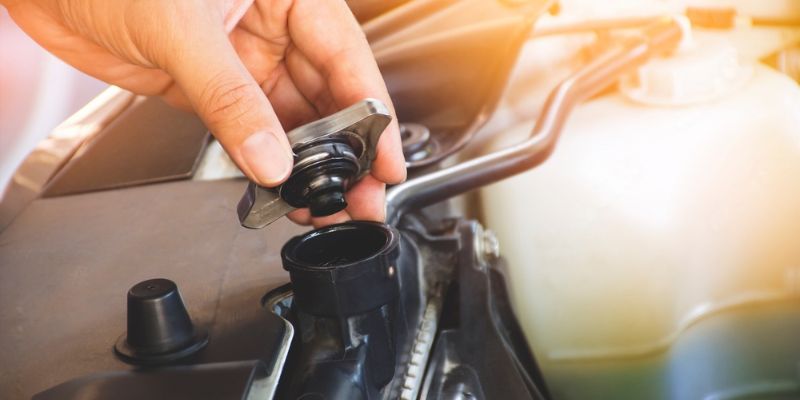When it comes to the cooling system of a vehicle, maintaining the proper coolant level is crucial for optimal engine performance and preventing overheating.
However, encountering a situation where there is no coolant in the radiator but reservoir tank is full can be perplexing.
In this article, we will explore the possible causes, implications, and recommended actions when facing this issue.
Firstly you need to understand the workings of the cooling system to find the reasons behind the absence of coolant in the radiator.
Understanding the Cooling System
Before delving into the specific scenario of no coolant in the radiator but a full reservoir tank, it’s essential to understand the basic components and functions of the vehicle’s cooling system.
a) Radiator
The radiator is a heat exchanger responsible for cooling the engine coolant. It consists of a network of tubes and fins through which the coolant flows.
As the coolant passes through the radiator, excess heat is dissipated into the surrounding air.
b) Reservoir Tank
Also known as the overflow or expansion tank, the reservoir tank serves as a storage container for excess coolant.
It allows for the expansion and contraction of the coolant as the engine temperature fluctuates. The reservoir tank is typically connected to the radiator through a hose, enabling the transfer of coolant between the two.
c) Water Pump
The water pump is responsible for circulating the coolant throughout the cooling system. Driven by the engine’s crankshaft, the water pump ensures a steady flow of coolant, facilitating the heat transfer process.
d) Thermostat
The thermostat helps regulate the engine’s operating temperature. It stays closed to prevent coolant flow until the engine reaches its optimal temperature.
Once the desired temperature is reached, the thermostat opens, allowing coolant to circulate and maintain a consistent temperature.
Now that we have a basic understanding of the cooling system, let’s explore why the radiator may have no coolant while the reservoir tank remains full.
5 Causes of no Coolant in the Radiator but Reservoir tank is full
There can be several reasons for the radiator to be devoid of coolant while the reservoir tank appears to be adequately filled. Understanding these causes can help diagnose the issue accurately and take appropriate action.
a) Coolant Leakage
One possible cause is coolant leakage from the radiator. A damaged or malfunctioning radiator can result in coolant escaping from the system.
This can lead to a decrease in coolant levels within the radiator while the reservoir tank remains full.
b) Faulty Radiator Cap
The radiator cap plays a vital role in maintaining the proper pressure within the cooling system.
If the radiator cap is faulty or not sealing correctly, it can cause coolant to bypass the radiator and accumulate in the reservoir tank, resulting in an imbalanced coolant distribution.
c) Air Pocket
An air pocket trapped within the cooling system can also contribute to the no coolant in the radiator but full reservoir tank situation.
Air pockets can disrupt the flow of coolant and prevent it from reaching the radiator, leading to inadequate cooling and a concentration of coolant in the reservoir tank.
d) Coolant Overflowing
In some instances, overfilling the reservoir tank can give the impression of a full tank while the radiator remains empty.
When the coolant expands due to engine heat, the excess can be pushed into the reservoir tank. If the tank is overfilled, it may not transfer the coolant back into the radiator properly, leaving the radiator without sufficient coolant.
e) Faulty Water Pump
There could be other malfunctions within the cooling system, such as a faulty water pump or thermostat, that may disrupt the proper circulation of coolant.
These issues can result in coolant bypassing the radiator and accumulating in the reservoir tank.
Fixing the No Coolant in Radiator issue
When facing the situation of no coolant in the radiator but a full reservoir tank, it is important to take appropriate actions to diagnose and resolve the issue. Here are some recommended steps to follow:
1. Cool Down the Engine
First and foremost, allow the engine to cool down before inspecting the cooling system. Working on a hot engine can be dangerous and may result in burns.
2. Check for Coolant Leakage
Inspect the radiator, hoses, and other components of the cooling system for any signs of coolant leakage. Look for visible coolant stains, wet spots, or puddles under the vehicle.
If leakage is detected, it is crucial to identify and address the source promptly. Common areas of leakage include radiator seams, hose connections, and water pump seals.
3. Inspect the Radiator Cap
Examine the radiator cap for any signs of damage or wear. A faulty radiator cap can cause coolant to bypass the radiator and accumulate in the reservoir tank.
If the cap shows signs of deterioration or does not seal properly, it is recommended to replace it with a new one.
4. Check for Air Pockets
Air pockets trapped within the cooling system can disrupt coolant flow to the radiator.
To remove air pockets, locate the coolant bleeder valve or screw on the cooling system (if present) and carefully release any trapped air.
Consult the vehicle’s manual for specific instructions on bleeding the cooling system.
5. Verify Coolant Levels
After the engine has cooled down, verify the coolant levels in both the radiator and the reservoir tank. If the radiator is empty or significantly low on coolant while the reservoir tank is full, it may indicate an issue with coolant circulation.
In such cases, it is recommended to consult a professional mechanic for a thorough inspection and diagnosis.
6. Perform a Flush and Refill
If necessary, consider performing a coolant flush to remove any contaminants or buildup within the cooling system.
Flushing the system involves draining the old coolant and replacing it with fresh coolant. Follow the vehicle manufacturer’s guidelines and use the recommended coolant type and mixture ratio.
It is essential to properly dispose of the old coolant according to local regulations.
7. Regular Maintenance
To prevent future issues with coolant distribution, follow the vehicle manufacturer’s recommended maintenance schedule.
This includes regular coolant checks, inspections for leaks, and preventive measures to ensure the cooling system operates optimally.
FAQs
Can I drive the vehicle if there’s no coolant in the radiator but the reservoir tank is full?
It is not recommended to drive a vehicle with no coolant in the radiator. Insufficient coolant in the radiator can lead to engine overheating and potential damage.
It is crucial to address the issue promptly before driving the vehicle.
Why is it important to maintain the proper coolant level?
Coolant helps regulate the engine’s operating temperature and prevents overheating. Maintaining the proper coolant level ensures efficient heat transfer and protects the engine from damage caused by excessive heat.
Can I simply add coolant to the radiator if it’s empty?
It is not advisable to add coolant directly to the radiator without addressing the underlying issue.
Simply adding coolant to the radiator may not resolve the problem if there is a leak or circulation issue. It is recommended to diagnose and fix the root cause before refilling the cooling system.
How often should I check the coolant level?
It is a good practice to check the coolant level regularly, especially before long trips or during routine maintenance.
Refer to the vehicle’s owner’s manual for specific recommendations on coolant level inspection and maintenance intervals.
Can I use water as a temporary coolant replacement?
In emergencies, water can be used temporarily as a coolant replacement. However, it is not a long-term solution as water lacks the necessary additives and corrosion inhibitors found in coolant.
It is important to replace water with the appropriate coolant mixture as soon as possible.
Conclusion
In conclusion, encountering a situation where there is no coolant in the radiator but the reservoir tank is full requires attention and proper diagnosis.
Possible causes include coolant leakage, a faulty radiator cap, air pockets, coolant overfilling, or other malfunctions within the cooling system.
It is essential to take recommended actions, such as checking for leaks, inspecting the radiator cap, releasing air pockets, and verifying coolant levels.
If necessary, perform a flush and refill or consult a professional mechanic for further inspection.
Regular maintenance and adherence to the vehicle manufacturer’s guidelines will help ensure a properly functioning cooling system and prevent issues related to coolant distribution.

Joseph Morgan has decades of automotive experience. The Detroit native started restoring classics in the 1970s. He owned a vintage repair shop and authored articles for car magazines. With a 1965 Mustang fastback of his own, Joseph now shares advice through his YouTube channel. From engine swaps to rust repair, his expertise helps preserve automotive history.
